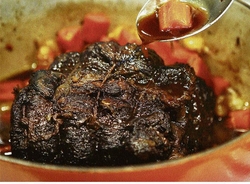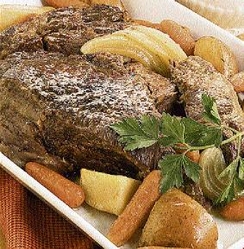Pot roast Sundays
Published: Saturday | August 22, 2009

Pot roast is indeed the quintessential Jewish-American Hanukkah dish, reflecting the history of the Eastern European Jews who settled in the United States.
Heather Little-White, Contributor
Sunday dinner is usually a special meal for the family, with the main course adding appeal. You may recall your mother or grandmother's preparation of roast beef in a manner that you savoured every bite during the meal or in that Sunday evening roast beef sandwich for supper. The cooking of beef at home gives off an aroma that brings a feeling of good home cooking.
Contrary to what the name suggests, the 'roast', which is a large, inexpensive cut of meat, is not actually roasted, which would require high, dry heat. Instead, the meat is braised until fork tender. Braising is a form of cooking by moist heat which breaks down connective tissues in tough cuts of meat making them tender and succulent. Meat for braising should be seared on the top of the stove first to give a brown outer crust. The high heat used during browning caramelises sugars and proteins in the meat, resulting in a rich flavour. To enhance browning of the meat, pat off excess moisture with clean paper towels before searing it.
A traditional pot roast is a Yankee pot roast with beef, vegetables and potatoes. Pot roast came about as a result of finding ways to cook cheaper, tougher cuts of meat from the animal's most used muscles - the leg, shoulder and neck - which yield better flavour when cooked. The length of the cooking time in the moist heat tenderises the meat, drawing out the gelatin which thickens the juices in the pan.
Heather Little-White, PhD, is a nutrition and lifestyle consultant in the Corporate Area. Email feedback to saturdaylife@gleanerjm.com.

Good old-fashioned Yankee pot roast makes a satisfying meal - all the more so if you have a slow cooker, allowing you to assemble dinner early then walk away knowing it will be ready when you are at day's end.
3-31/2 hours
1 boneless beef chuck pot roast (arm, shoulder or blade) (21/2lb)
1/3 cup all-purpose flour
1 tbsp vegetable oil
2 cups beef broth
1/2 cup dry red wine
11/2 tsp dried thyme
1 potato, diced
1 carrot, diced
Method:
1. Combine flour and 3/4tsp each salt and pepper. Lightly coat beef pot roast with 2tbsp flour mixture. Heat oil in heavy-bottomed skillet over medium heat until hot; brown pot roast.
2. Mix remaining flour mixture with broth, wine and thyme until smooth. Add to pot; bring to a boil. Reduce heat; cover tightly and simmer for 2 hours. Add vegetables and potato; bring to a boil. Reduce heat; simmer, covered, 30 to 45 minutes or until beef and vegetables are fork-tender. Skim fat.
3. Carve pot roast; season with salt. Serve with vegetables and sauce.
6 servings
Source: www.marsh.net
Selecting beef
There are different cuts of pot roast, depending on the part of the body from which the meat comes. Your butcher should be able to select the cut for roasting if you are not sure what to select.
For beef: boneless chuck roast offers flavour with a controlled amount of fat. Other cuts without bone include the shoulder, rump or eye of the round.
For pork: lean pork loin will be juicy but not as tender; Boston butt will need a longer cooking time to become tender.
For lamb: a butterfly leg will become tender to melt in the mouth and rendered juices make a silky sauce.
Whatever cut you choose, allow a half a pound per person and trim off any excess fat. Buy more meat than you will need for the Sunday dinner as leftover pot roast make great dishes.
Cooking method
Select the right type of pan for pot roasting. The pot should not be too tall and should have a tight fitting lid. A Dutch oven is a good selection and should be large enough to hold the meat, vegetables and braising liquid. If pot is too large, evaporation will take place and dry up the braising liquid. A roasting pan can be tightly covered with aluminium foil and works well, especially for larger cuts of meat. Pot-roasting may be done on top of the stove and should be cooked in braising liquid.
Prepare the meat for cooking by studding the meat with garlic, thyme and scallion and marinating after rubbing it with spices to enrich the flavour of the roast.
When cooking a boneless roast, it is best to tie with butcher's twine at two-inch intervals to allow for uniform cooking and moisture retention. You can lavishly add herbs, spices and fruit-like currants, pineapple with a hint of orange before tying to give more flavour to the meat.
The choice of braising liquids is important to the finished product. Great choices are red wine, white wine or chicken stock.
Add vegetables to the meat for a one-pot meal. Aromatic additions include onions, celery and carrots. Tomatoes add moisture and break down during cooking, which naturally thickens the sauce. Add vegetables about one hour before the meat is done.
Test for doneness
Cooking time is generally one hour of cooking time per pound of meat. The meat is cooked when it is tender and easily pierced in the thickest part with a sharp fork. The juices should run clear. Overcooking the meat beyond the fork-tender stage may result in the beef being stringy. The meat should be allowed to rest to allow the juices to redistribute within the meat. While the meat rests, you can make the gravy and prepare the sides.
Roast beef is traditionally served 'rare' or 'pink', meaning that the centre of the joint is warmed but not cooked so that it retains the red colour of raw beef. It should be noted, however, that there are health risks associated with rare beef if cooked below 130F.
Carving the beef
Carve chuck pot roast into thin to medium slices.
Carve round roast into thin slices.
Carve brisket and corned beef diagonally across the grain into thin slices.
(culinaryarts.about.com)
Best pan gravy
The test of a well-done pot roast is the gravy. Some roasts like pot roast are served with their own juices. The juices are also used to make sauces to accompany the roast.
Steps in making the sauce
1. While the roast is resting, gently tilt the pan and spoon the fat away, being careful not to stir in the fat into the juices.
2. Place the juices in a saucepan and set half of the pan over high flame. This allows the fat to move to the coolest part of the pot where it can be easily spoon off.
3. You will need a ladle when there is a lot of liquid. Use the ladle to skim the fat off the surface by dipping the ladle under the layer of fat so that it swirls into the ladle's bowl.
4. Strain the juices into a cup.
5. If the pot roast is made ahead of time, place the strained juices in the refrigerator and allow the fat to harden on the surface. Remove the fat by lifting it in its solid state.
6. Reheat the roast by returning it to the pan. Adding some of the degreased juices, cover the roast tightly and warm in a low oven.
Making a silky sauce
Whisk in several pats of cold butter or a bit of cream.
A little mustard or tomato paste will give the sauce body and bright colour.
For a thick, gravy-like sauce, purée the pan vegetables with degreased juices and season to taste. Avoid using cornstarch or flour to thicken sauces or gravy as they can make them muddy and thick.
